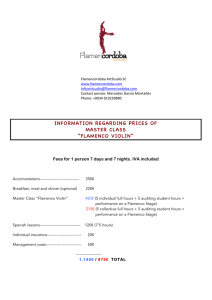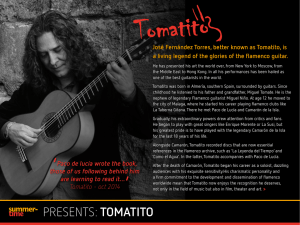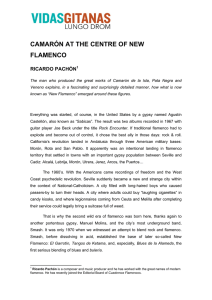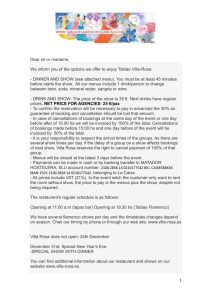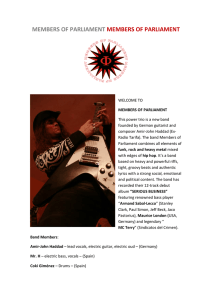Course GB-09 FLAMENCO: AN EXPRESSION
Anuncio
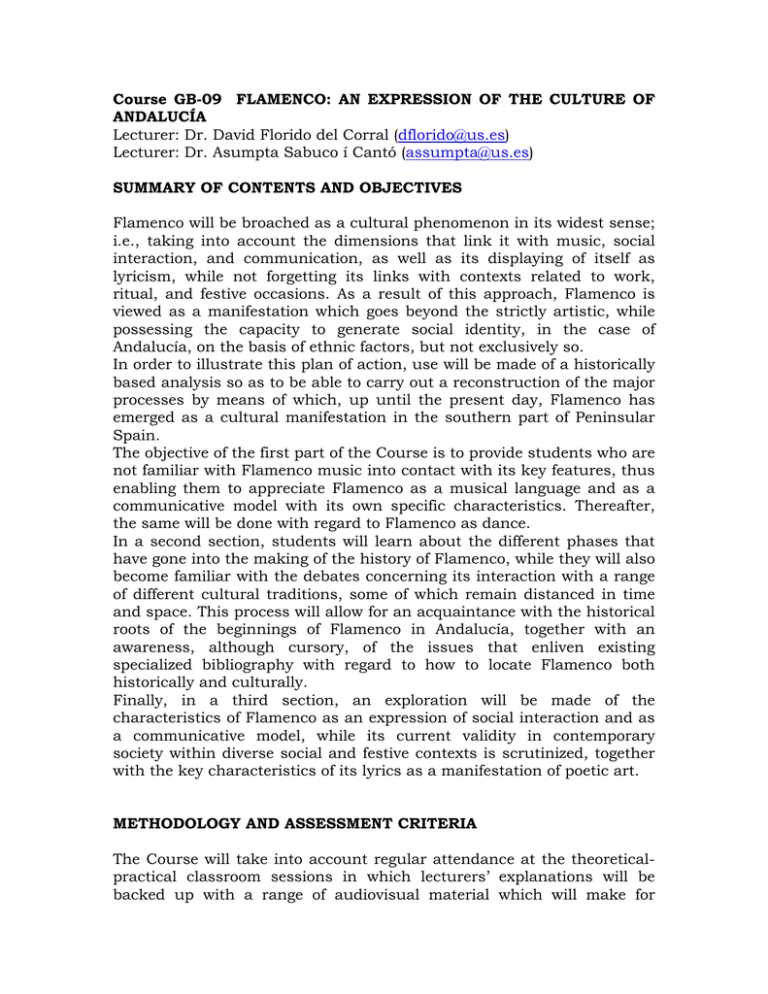
Course GB-09 FLAMENCO: AN EXPRESSION OF THE CULTURE OF ANDALUCÍA Lecturer: Dr. David Florido del Corral (dflorido@us.es) Lecturer: Dr. Asumpta Sabuco í Cantó (assumpta@us.es) SUMMARY OF CONTENTS AND OBJECTIVES Flamenco will be broached as a cultural phenomenon in its widest sense; i.e., taking into account the dimensions that link it with music, social interaction, and communication, as well as its displaying of itself as lyricism, while not forgetting its links with contexts related to work, ritual, and festive occasions. As a result of this approach, Flamenco is viewed as a manifestation which goes beyond the strictly artistic, while possessing the capacity to generate social identity, in the case of Andalucía, on the basis of ethnic factors, but not exclusively so. In order to illustrate this plan of action, use will be made of a historically based analysis so as to be able to carry out a reconstruction of the major processes by means of which, up until the present day, Flamenco has emerged as a cultural manifestation in the southern part of Peninsular Spain. The objective of the first part of the Course is to provide students who are not familiar with Flamenco music into contact with its key features, thus enabling them to appreciate Flamenco as a musical language and as a communicative model with its own specific characteristics. Thereafter, the same will be done with regard to Flamenco as dance. In a second section, students will learn about the different phases that have gone into the making of the history of Flamenco, while they will also become familiar with the debates concerning its interaction with a range of different cultural traditions, some of which remain distanced in time and space. This process will allow for an acquaintance with the historical roots of the beginnings of Flamenco in Andalucía, together with an awareness, although cursory, of the issues that enliven existing specialized bibliography with regard to how to locate Flamenco both historically and culturally. Finally, in a third section, an exploration will be made of the characteristics of Flamenco as an expression of social interaction and as a communicative model, while its current validity in contemporary society within diverse social and festive contexts is scrutinized, together with the key characteristics of its lyrics as a manifestation of poetic art. METHODOLOGY AND ASSESSMENT CRITERIA The Course will take into account regular attendance at the theoreticalpractical classroom sessions in which lecturers’ explanations will be backed up with a range of audiovisual material which will make for practical learning. Likewise, texts, outlines and different kinds of illustrative material will be provided as a way of reinforcing the explanations concerned. In general, the two-hour sessions will be divided into sub-units, each respectively dedicated to both theoretical content and to practical exercises so as to ensure an applied learning process in which students will be able participate actively as protagonists. By way of a complementary, extramural activity, students will be expected to undertake two brief practical assignments involving the analysis of two public performances, or events, in which Flamenco is on show, either commercially, or socially. As a result of this outline, criteria for assessment and grading will be as follows: Attendance and participation: Account will be taken of regular attendance and active participation in the learning activities during each session. With this aim in mind, a class register will be kept. A maximum of five unwarranted absences during the semester will be permitted, while, during the first two weeks of class, it will be each student’s responsibility to hand in a file card which will include his or her name, a photograph, details of the Program to which he or she belongs, as well as an e-mail address. During class sessions lecturers will encourage students to play a participative role in the activities and exercises that will be set up. Weighting within final grade: 20%. The undertaking of a short assignment which, from a comparative standpoint, will involve the analysis of two public performances or events in which Flamenco is on display. As class sessions go forward, an explanation will be given of what is involved in the structure, content and requirements of the assignment, while written guidelines will also be provided. In this same sense, students are recommended to attend tutorial hours so that lecturers may oversee the development of each assignment. Assignments are to be handed in at the close of the semester. Weighting within final grade: 40% The sitting of an exam in which each student is expected to be able to analyze an across-the-board subject from within the syllabus, while also confirming an ability to comment on visual material in which Flamenco is involved. Also, he or she will be expected to answer questions with reference to concepts and terms explained during class sessions. As the Course progresses, students will be provided with past-papers, together with models concerning how to answer subject-based and concept-based questions so that they become familiar with what is expected of them in this kind of exercise. Weighting within final grade: 40% SYLLABUS SESSIONS AND DISTRIBUTION OF THEORETICAL-PRACTICAL 1. Introduction: Flamenco as the expression of what is musical, of ritual, and of social interaction. Its relation to cultural identity within Andalucía and to the cultural traditions that go into that same identity’s making. 2. Key characteristics of Flamenco as musical expression: components of the musical discourse concerned, rhythm, styles, or handles on style. Approaches to the learning and performance of Flamenco music: microcomposition, resources of expression, instrumentalization. Sounding Flamenco-like. 3. Expressive characteristics of Flamenco as dance: counterpointing as the structural basis of Flamenco dance, the structure of dance set-ups, the recent evolution of dance forms. 4. The origins of Flamenco as a junction of viewpoints. Historical/cultural context, from the Enlightenment to Romanticism. The issue of the term Flamenco. 5. Historical reconstruction of commercial Flamenco. Phases: the cafésinger, Flamenco opera, Neoclassicism, Present-day Flamenco. Issues concerning the identity of Flamenco as Music: Flamenco and Andalusí culture, gipsy style, purists and ‘cante-jondo flamencans’, Flamenco and Heritage. 6. Flamenco and its social dimension: the practice of ‘using’ Flamenco. Everyday contexts for Flamenco: the family circle, neighborhoods, festive occasions. 7. Flamenco as literary expression. Key characteristics of its language and of the structure of the ‘copla’ ballads. BIBLIOGRAPHY The bibliography below should be seen as an index of those texts which can be made use of by students as a way of delving deeper into the subject-units made available. ANONYMOUS (Bachiller Revoltoso), 1995 [1750]. Libro de la Gitanería de Triana de los años 1740 a 1750 que escribió el bachiller revoltoso para que no se imprimiera. Prólogo y Edición de Antonio Castro Carrasco. Sevilla. AIX GARCÍA, F. 2002: “El arte flamenco como campo de producción cultural. Aproximación a sus aspectos sociales”. En Anduli, Revista Andaluza de Ciencias Sociales, nº 1. BALTANÁS, E. y PIÑERO P. M. 1998: “El flamenco y los gitanos en The Zincali de Georges Borrow”. EN STEINGRESS, G. y E. BALTANÁS (Eds.) 1998: Flamenco y nacionalismo. Aportaciones para una sociología política del flamenco. Universidad de Sevilla y Fundación Machado. Sevilla, pp. 81-92. BARRIOS, M. 2000 [1972]. Ese difícil mundo del flamenco. Universidad de Sevilla. BERNAL, A. M. 1989: “Sobre el campesinado andaluz y el flamenco”. En VV.AA. 1989: Silverio Franconetti. 100 años que murió y aún vive. Ayuntamiento de Sevilla, pp. 51-58. BORROW, G.H. 1999: Los Zíncali: los gitanos de España. Madrid. Turner. CONSEJERÍA DE TURISMO Y DEPORTE (REGIONAL BOARD OF TOURISM AND SPORT). 2002. Guía del Flamenco de Andalucía. Sevilla, Junta de Andalucía. Incluye 2 CDs. Los archivos de texto y de sonido se puede descargar del sitio: www.andaluciaflamenco.org CRUCES ROLDÁN, C. 2004/2002: Más allá de la Música: Antropología y Flamenco (I) y (II). Signatura Ediciones. Sevilla. CRUCES ROLDÁN, C. 2001: Flamenco y Patrimonio. Bienal de Flamenco de Sevilla. Sevilla. CRUCES ROLDÁN, C. 1999: “Flamenco e Identidad Andaluza”. En Ponencias sobre “El hecho diferencial andaluz”. Consejería de Relaciones con el Parlamento, Junta de Andalucía, pp. 121-148. CRUCES ROLDÁN, C. 1993: “Clamaba un minero así…” Identidades sociales y trabajo en los cantes mineros. Universidad de Murcia. CRUCES ROLDÁN (Ed.), 1996: El flamenco: identidades sociales, ritual y patrimonio cultural. Centro Andaluz de Flamenco. Jerez de la Frontera GELARDO NAVARRO, J. 1998: “El flamenco, ¿identidad andaluza o identidad de una clase (la de los desposeídos) en Andalucía? En STEINGRESS, G. y E. BALTANÁS (Eds.) 1998: Flamenco y nacionalismo. Aportaciones para una sociología política del flamenco. Sevilla. Universidad de Sevilla y Fundación Machado, pp. 223-238. GRANDE, F. 1979. Memoria del flamenco. II Vols. Escasa Calpe, Madrid. GONZÁLEZ TROYANO, A. 1989: “Noticia cultural de un tiempo romántico”. En VV.AA. 1989: Silverio Franconetti. 100 años que murió y aún vive. Ayuntamiento de Sevilla, pp. 81-87. INFANTE, B. 1990: Orígenes de lo flamenco y el secreto del cante jondo. Consejería de Cultura, Junta de Andalucía. Sevilla. LARREA, A. 2004 [1974]. El flamenco en su raíz. Signatura Ediciones. Sevilla. LAVAUR, L. 1976: Teoría romántica del cante flamenco. Editorial Nacional. Madrid. LEBLON, B. 1991: El cante flamenco: entre las músicas gitanas y las tradiciones andaluzas. Madrid, Ed. Cinterco. MACHADO and ÁLVAREZ, A. (“DEMÓFILO”), 1881. Colección de cantes flamencos. Sevilla. Hay reedición en Signatura Ediciones en 2004 y de sus obras completas en 2005. MARTÍ, J. 1998: “Discursos musicológicos como constructor etnicitarios”. En STEINGRESS, G. y E. BALTANÁS (Eds.) 1998: Flamenco y nacionalismo. Aportaciones para una sociología política del flamenco. Universidad de Sevilla y Fundación Machado. Sevilla, pp. 125-136. MOLINA, R. y A. MAIRENA. Mundo y formas del cante flamenco. Sevilla, Librería Al-Andalus. MORENO NAVARRO, I. 1996. “El flamenco en la cultura andaluza”. En CRUCES ROLDÁN (Ed.), 1996: El flamenco: identidades sociales, ritual y patrimonio cultural. Centro Andaluz de Flamenco. Sevilla, pp. 15-34. NAVARRO GARCÍA, J.L. 1998: Semillas de ébano. El elemento negro y afroamericano en el baile flamenco. Portada Editorial. Sevilla. NAVARRO GARCÍA, J.L. y ROPERO NÚÑEZ, M. (Dirs.) 1995. Historia del flamenco. V vols. Tartessos, Sevilla ORTIZ NUEVO, J.L. 1996. A su paso por Sevilla : noticias del flamenco en Serva, desde sus principios hasta la conclusión del siglo XIX. Ayuntamiento de Sevilla. Área de Cultura. ORTIZ NUEVO, J.L. 1990: ¿Se sabe algo? Viaje al conocimiento del Arte Flamenco en la prensa sevillana del siglo XIX. Ediciones el carro de la nieve. Sevilla. PENNA, M. 1996: El flamenco y los flamencos. Historia de los gitanos españoles. Portada Editorial. Sevilla. 2 vols. PINEDA NOVO, D. 1991. Antonio Machado y Álvarez “Demófilo”. Vida y obra del primer flamencólogo español. Editorial Cinterco. Madrid. PLAZA ORELLANA, R. 1999. El flamenco y los románticos. Un viaje entre el mito y la realidad. Sevilla, Bienal de Arte Flamenco PLAZA ORELLANA, R. 2006: Bailes de Andalucía en Londres y París (1830-1850). Madrid. Ed. Arambel Editores. RÍOS RUIZ, M. y BLAS VEGA, J. 1988. Diccionario enciclopédico ilustrado del flamenco. Madrid: Cinterco. ROPERO NÚÑEZ, M. 1984. El léxico andaluz de las coplas flamencas. Universidad de Sevilla SCHUCHARDT, H. 1990 [1881]. Los cantes flamencos. Sevilla. Fundación Machado. Ed. de G. Steingress, M. Wolf y E. Feenstra. STEINGRESS, G. 1993. Sociología del cante flamenco. Fundación Andaluza de Flamenco. Jerez de la Frontera. STEINGRESS, G. 1998: Sobre flamenco y flamencología. Signatura Ediciones. Sevilla STEINGRESS, G. 1996: “Ambiente flamenco y bohemia andaluza. Unos apuntes sobre el origen post-romántico del género gitano-andaluz”. En CRUCES ROLDÁN (Ed.), 1996: El flamenco: identidades sociales, ritual y patrimonio cultural. Centro Andaluz de Flamenco, pp. 83-110. STEINGRESS, G. 2006. “…y Carmen se fue a París. Un estudio sobre la construcción artística del género flamenco 1833-1865”. Almuzara, Córdoba. UTRILLA ALMAGRO, J. 2007. El flamenco se aprende. Teoría y didáctica para la enseñanza del flamenco. Córdoba: Ediciones Toro Mítico. ZOIDO NARANJO, A. 1999: La prisión general de los gitanos y los orígenes de lo flamenco. Portada Editorial. Sevilla.
